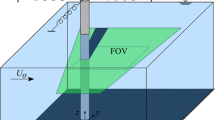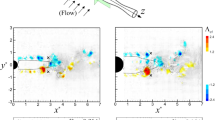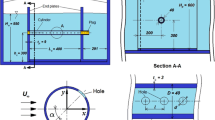Abstract
The wake dynamics behind a seal-vibrissa-shaped cylinder, which are closely related to the seal’s extraordinary ability to faithfully track the hydrodynamic trails of its upstream prey, were extensively studied by using time-resolved particle image velocity. Four cylindrical configurations that shared the same hydrodynamic diameter (i.e., a circular cylinder, an elliptical cylinder, a wavy cylinder, and a vibrissa-shaped cylinder) were chosen for the comparative study at the Reynolds number 1.8 × 103. The instantaneous flow fields behind the cylinders were measured along their vertical and horizontal planes. The distinct global differences between the wakes were determined from the streamline patterns, the reverse-flow intermittences, and both the streamwise and longitudinal velocity fluctuation intensities. Compared to the other three systems tested, the vibrissa-shaped cylinder system was characterized by a considerably reduced recirculation zone in the nodal plane, the existence of a very stably reversed flow, and substantial reductions in the streamwise and longitudinal velocity fluctuation intensities. Further cross-correlation of the fluctuating longitudinal velocities showed that the unsteady events behind the vibrissa-shaped cylinder were poorly organized by sequence and considerably constrained in their spatial extent. Finally, a dynamic mode decomposition (DMD) was performed on the instantaneously varying wake flows. In the wavy cylinder system, a single dominant DMD mode at St = 0.2 (corresponding to Karman vortex street) was detected in both the saddle and nodal planes. Although the dominant DMD modes at St = 0.23 and 0.3 were determined in the saddle and nodal planes of the vibrissa-shaped cylinder system, respectively, the spatial pattern of these two DMD modes showed resolved vortical structures that were highly distorted and constrained to an extremely limited space. These DMD modes had much less energy than those in the other three systems. The phase-dependent variations of the wake flows disclosed that the complex unsteady behavior at distinctly different frequencies in the saddle and nodal planes disrupted the regular vortex shedding process, suppressing the vortex-induced vibration of the vibrissa-shaped cylinder.















Similar content being viewed by others
Abbreviations
- CCD:
-
Charge-coupled device
- CMOS:
-
Complementary metal oxide semiconductor
- DMD:
-
Dynamic mode decomposition
- PIV:
-
Particle image velocimetry
- POD:
-
Proper orthogonal decomposition
- RAID:
-
Redundant arrays of independent disks
- SSD:
-
Solid-state disk
- TR-PIV:
-
Time-resolved particle image velocimetry
- VIV:
-
Vortex-induced vibration
- B :
-
System matrix
- C :
-
Companion matrix
- D h :
-
Hydraulic diameter [m]
- Re D :
-
Reynolds number (based on the hydraulic diameter)
- f :
-
Frequency [Hz]
- U :
-
Discrete velocity matrix
- U 0 :
-
Free-stream velocity [ms−1]
- \(Uc\) :
-
Convection speed of the vortices [ms−1]
- \({\bar{u}}\) :
-
Time-averaged streamwise velocity [ms−1]
- u′:
-
Fluctuating part of the streamwise velocity [ms−1]
- \({u}_{\text{rms}}^{{\prime }}\) :
-
Root mean square of the streamwise velocity fluctuations [ms−1]
- v′:
-
Fluctuating part of the longitudinal velocity [ms−1]
- x :
-
Streamwise coordinate [m]
- y :
-
Longitudinal coordinate [m]
- z :
-
Spanwise coordinate [m]
- x 0 :
-
Streamwise coordinate of the reference point [m]
- St :
-
Strouhal number
- \(\rho_{vv}\) :
-
Two-point spatial v–v correlation
- \(\rho_{uu}\) :
-
Two-point spatial u–u correlation
- \(\tau\) :
-
Time delay [s]
- \(\gamma_{t}\) :
-
Reverse-flow intermittency coefficient
- \(\varPhi\) :
-
Dynamic modes
- \(\parallel {\phi} \parallel\) :
-
DMD eigenfunction
- \(\lambda_{ci}\) :
-
Swirling strength
References
Adrian RJ, Christensen T, Liu Z (2000) Analysis and interpretation of instantaneous turbulent velocity fields. Exp Fluids 29:275–290
Beem H, Hildner M, Triantafyllou M (2013) Calibration and validation of a harbor seal whisker-inspired flow sensor. Smart Mater Struct 22:014012
Dehnhardt G, Mauck B, Bleckmann H (1998) Seal whiskers detect water movements. Nature 394:235–236
Dehnhardt G, Mauck B, Hanke W, Bleckmann H (2001) Hydrodynamic trail-following in harbor seals (Phoca vitulina). Science 293:102–104
Hanke W, Witte M, Miersch L, Brede M, Oeffner J, Michael M, Hanke F, Leder A, Dehnhardt G (2010) Harbor seal vibrissa morphology suppresses vortex-induced vibrations. J Exp Biol 213:2665–2672
Lam K, Wang F, So R (2004) Three-dimensional nature of vortices in the near wake of a wavy cylinder. J Fluids Struct 19:815–833
Liu YZ, Zhang QS (2015) Dynamic mode decomposition of separated flow over a finite blunt plate: time-resolved particle image velocimetry measurements. Exp Fluids 56:1–17
Liu YZ, Shi LL, Yu J (2011) TR-PIV measurements of the wake behind a grooved cylinder at low Reynolds number. J Fluids Struct 27(2011):394–407
Miersch L, Hanke W, Wieskotten S, Hanke F, Oeffner J, Leder A, Brede M, Witte M, Dehnhardt G (2011) Flow sensing by pinniped whiskers. Philos Trans R Soc B Biol Sci 366:3077–3084
Raman SK, Prakash KA, Vengadesan S (2013) Effect of axis ratio on fluid flow around an elliptic cylinder: a numerical study. J Fluids Eng 135:111201
Rowley CW, Mezić I, Bagheri S, Schlatter P, Henningson D (2009) Spectral analysis of nonlinear flows. J Fluid Mech 641:115–127
Ruhe A (1984) Rational Krylov sequence methods for eigenvalue computation. Linear Algebra Appl 58:391–405
Schmid PJ (2010) Dynamic mode decomposition of numerical and experimental data. J Fluid Mech 656:5–28
Schulte-Pelkum N, Wieskotten S, Hanke W, Dehnhardt G, Mauck B (2007) Tracking of biogenic hydrodynamic trails in harbour seals (Phoca vitulina). J Exp Biol 210:781–787
Sirovich L (1987) Turbulence and the dynamics of coherent structures. Part I: Coherent structures. Q Appl Math 45:561–571
Witte M, Hanke W, Wieskotten S, Miersch L, Brede M, Dehnhardt G, Leder A (2012) On the wake flow dynamics behind harbor seal vibrissae: a fluid mechanical explanation for an extraordinary capability. In: Tropea C, Bleckmann H (eds) Nature-inspired fluid mechanics. Springer, Berlin, Heidelberg, pp. 271–289
Zhang QS, Liu YZ (2015) Influence of incident vortex street on separated flow around a finite blunt plate: PIV measurement and POD analysis. J Fluids Struct 55:463–483
Zhang QS, Liu YZ, Wang SF (2014) The identification of coherent structures using proper orthogonal decomposition and dynamic mode decomposition. J Fluids Struct 49:53–72
Acknowledgments
The authors gratefully acknowledge financial support for this study from the National Natural Science Foundation of China (Grant No. 11372189).
Author information
Authors and Affiliations
Corresponding author
Ethics declarations
Conflict of interest
The authors declare that they have no conflict of interest.
Rights and permissions
About this article
Cite this article
Wang, S., Liu, Y. Wake dynamics behind a seal-vibrissa-shaped cylinder: a comparative study by time-resolved particle velocimetry measurements. Exp Fluids 57, 32 (2016). https://doi.org/10.1007/s00348-016-2117-9
Received:
Revised:
Accepted:
Published:
DOI: https://doi.org/10.1007/s00348-016-2117-9




